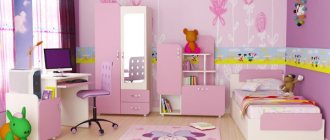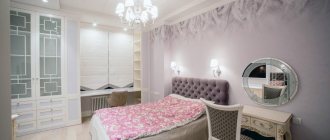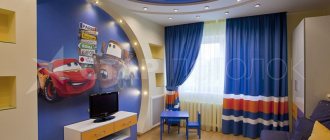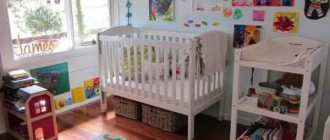assets/from_origin/upload/resize_cache/iblock/6d8/600_450_2/6d840fcb291811e01f4d3b21d1391c63.jpg From this article you will learn:
- Can the color of a children's room affect the mood and even the health of a child?
- What color of a children's room should parents of temperamental children prefer?
- Is it possible to decorate a children's room entirely in one color?
- Is it necessary to dilute the white color in the interior of a children's room with bright accents?
- What color can you decorate a room for a girl and a boy?
All mothers and fathers want their children to grow up in good conditions. Arranging a child's room is one of the most important processes for parents of a baby. When preparing the room, you should pay attention to many nuances that will affect the mood, physical health and psychological development of the child. In this article we will answer the question of what color to choose for a children's room to create a comfortable and cozy environment.
Where to start choosing the color of a children's room
They usually try to design a nursery using bright colors; they also install unusual upholstered furniture. This raises important questions: what shade of wallpaper should I choose for the children’s room or what color should I paint the walls of the nursery? There is no definite answer to these questions, since the final solution will be based on many factors.
When choosing a color scheme, you need to keep in mind:
- Gender of the baby.
- Child's age.
- Taste preferences.
- Individual characteristics of the baby.
Take the test
In addition, it is worth paying attention to the specifics of the children's room itself. There are times when the shades you like are not suitable for a certain room due to several reasons:
- nursery location;
- lighting level in the room;
- dimensions of the children's room;
- furniture that has already been selected.
Interior styles
Provence style will harmoniously complement a girl’s nursery. This direction is distinguished by a pastel, faded palette, wooden elements, natural textiles and antique antique furniture pieces. There is a lot of light in the interior, and there is a sense of spaciousness.
The photo shows blue color in the interior of a girl’s bedroom in Provence style.
Multifunctional and free minimalism includes high-quality, environmentally friendly and durable elements, and does not have unnecessary expressive decor and unnecessary trinkets. The design welcomes restrained colors and allows for small bright inclusions.
The most popular solution for blue or light blue colors represents a marine style. With such a design, various decorations are appropriate, in the form of steering wheels, ropes, lifebuoys, toy anchors and other things. The surface of the walls is decorated with drawings of fish or other sea creatures, and a fabric imitating a sail is fixed to the ceiling.
What color is the children's room and how does it affect mood and health?
- White
Universal white is great as an answer to the question of what color of a children's room is best for a child. A bright room has a beneficial effect on people's mood and perfectly reflects sunlight and artificial light. However, a large amount of this color subconsciously evokes a feeling of restraint. A white ceiling in a room is quite acceptable, but walls painted white, combined with light-colored furniture, can curb a child’s enthusiasm and inspiration. For a child's room, it is better to opt for a milky, cream or beige color.
In its unchanged form, a room that is too light and monochromatic is not suitable for boys and girls. If you decide to make walls in these shades, add bright details in the form of furniture and other decorative elements.
- Red
Red helps increase brain activity, stimulates brain activity, improves mood. But do not forget that your child will also rest in this room, so try not to overdo it with these shades. Red curtains or other textiles can interfere with your baby's healthy sleep. From this we can conclude that it is better to use red as accents in the interior. For example, a bright red glass vase or a lampshade on a table lamp will look good.
- Orange
This color is not as aggressive as red, although they are somewhat similar. It sparks creativity and, in some cases, even boosts self-esteem. Orange shades can improve mood and increase appetite. However, despite all the advantages, you should not overload the nursery with this color. You can, for example, focus on one wall and paint it orange. But this technique should be used only if the baby’s gaze is not directed at a bright wall while resting.
- Yellow
Yellow color has many different shades - from bright to calm tones. Basically, this color helps to awaken activity and improve attention.
Recommended articles on this topic:
- Children's room design
- Bedroom interior
- How to make an apartment cozy
In a room with yellow flowers, a person is not threatened with depressive, sad states. In addition, an interesting fact is known: grades in exams held in rooms with yellow walls are usually higher. This color encourages you to gain new knowledge and helps you concentrate.
- Green
This color is common in living nature and promotes relaxation. Perhaps in such an environment a person intuitively feels himself in a natural safe environment. All shades of green have a positive effect on overly active children, but if the baby is already slow and calm, then a room of this color can worsen the situation. Balance can only be achieved with the right combination of green and other colors.
- Blue
The color blue is not as simple as it might seem. On the one hand, it helps you relax and unwind. On the other hand, it interferes with concentration and does not allow you to concentrate. This situation is very correctly described by the phrase “flying in the clouds.” Blue should be placed in the relaxation area and avoided near the desk.
- Blue
This color behaves quite capriciously in rooms. One of the positive aspects is that it has a beneficial effect on sleep and relieves fatigue well. However, it is no coincidence that the English word translated as blue is a homonym for blues. A large amount of blue color has a bad effect on attention and makes you feel sad.
- Violet
The color purple is a controversial topic among psychologists. Some consider it the color of creative people, while others think that this color is close to fantasy and makes you forget about reality. But in any case, shades of purple (as well as red) are best used as accents. And it is advisable to use a light color rather than a rich and deep one.
- Grey
Many people associate this color with boredom and monotony. But it is worth noting that, like all other colors, gray has its advantages. It has a calming effect and instills confidence. It is not for nothing that it is used so often to make business suits. To make the nursery look interesting, add bright colors, because gray goes well with other colors.
- Black
This color is not recommended for decorating the walls of a children's room. Sometimes teenagers deliberately add black elements to the interior. This is not a reason for special worries, but if this happens, you should pay attention to all changes in the child’s actions. Perhaps at the moment the son or daughter really needs parental understanding and support.
One way or another, teenage boys will love a room decorated in black and white.
Knowing the baby’s hobbies and character, parents will be able to make the right choice and determine which wall color for the children’s room is best suited to create harmony. Thanks to color balance, sleep and academic performance will improve. Of course, you shouldn’t paint a child’s room one shade and hope that all problems will be solved. For the correct timely development of personality, it is necessary to remember other, equally important factors.
Not easy for young men!
The myth of today is that many people believe that blue is only suitable for a boy, and pink will be the ideal modern art choice for a little princess.
While we agree that crimson interiors look stunning, there is no reason why turquoise can't be used in such spaces.
In contrast to pinkish, rooms in blue tones can offer an excellent backdrop for a young girl's boudoir. And all you need is to add captivating accessories and decorative elements in a sunny yellow or even orange creative palette to your design.
Add feminine decor and decorations to transform a gender-neutral cornflower blue nursery into a magical world for a little princess. Wall murals and lettering can further add visual softness to this setting.
Ultramarine wall decoration for a baby from the JJ Group design bureau
Gorgeous interior with textured wood accents, cool colors and crimson textiles by Stefan Radtke / Erika Mercurio
Charming room in snow-white, light blue and yellow colors from LLB
Chic modern design in indigo with original and fun wall decals from Signature Homes
An eclectic mix of decor with splashes of turquoise from Shryne Studio
A calming environment in an azure stylistic design with non-standard walls. Art by Jen Talbot Workshop
What color combination to choose for a children's room: rules for a harmonious interior
Do not forget that the interior will be more interesting if you combine colors in decoration and furnishings in an original way. Thus, it is possible to allocate separate zones for various types of children’s activities: a place to sleep, play and study. Each requires a correctly selected color arrangement. Zoning the nursery will help instill in the child the habit of order.
Children perceive colors very sensitively, so choosing a palette for your baby’s room should be approached responsibly. Next, we will tell you how to find the right solution and what color scheme to prefer so that children are as comfortable as possible.
Rule 1: Combine bright colors with neutrals.
With age, a child's preferences usually change: children 5–9 years old often like bright colors, such as red, crimson, orange, while teenagers tend to choose more subdued colors - beige, yellow and green. Therefore, the best solution would be to use bright colors as accents on some interior details, while leaving the walls neutral. This will help balance the area of the room and in the future, easily replace these decorative elements with others.
Rule 2: Choose light over dark.
When arranging a nursery, do not use dark color transitions, since shades that gradually turn into black have a negative impact on the child’s psyche. Light colors, on the contrary, will immediately fill the room with a pleasant, joyful atmosphere, which will have a beneficial effect on the development of children. An excellent solution would be to use ivory shades with the addition of golden specks and paint the walls with sky blue paint.
Rule 3. Pay attention to the location of the windows.
The position of the nursery is of great importance. The amount of sunlight is extremely important for the mental development and physical health of babies: constant exposure to a dark and cold room can lead to fatigue, drowsiness and discomfort.
Therefore, if the room’s windows are located on the north or west side, choose light, warm shades and add bright colors. A children's room located in the south or east requires the use of cold tones; they will look quite interesting. Also a good solution would be to combine warm and cold delicate shades, for example, light gray and yellowish.
Rule 4. Use good combinations
A good idea would be to use a two-tone design for a children's room. A combination of light green and sandy shades with a slight addition of specks of opposite tones will add a certain originality and beauty to the room. A gray palette with orange details or a light lilac shade will look quite elegant. And the usual combination of light green and pink will help enliven the space and fill it with special energy. Look for the right combinations!
Rule 5. Allow children to choose for themselves.
The children's room must be liked by the child himself. Be sure to find out your child's opinion about the design of the room - most likely, you will get new ideas. Don’t forget to offer your own options - this way you will take into account the children’s preferences and not make a mistake in choosing shades.
It makes no sense to ask your child what color to paint the children's room. Better ask: “Do you like this yellow or this green better?”
Rule 6. Take ideas from the Scandinavian style.
Scandinavian style details are often used in the interior of children's rooms - it is laconic and involves the use of eco-friendly materials and a light range of shades. However, some designers are interested in the question: are Scandinavian cool tones suitable for a children's room?
Currently, the Scandinavian new style is in demand, where the main shade is not traditional white, but completely different tones. They certainly remain calm, but also add an interesting character to the room, which is very suitable for a nursery. For example, it could be pale green, peach, gray, salmon and other unusual shades.
Romantic red and white room
Red for girls is a symbol of strong love. A red and white room looks romantic: white decoration of the rooms or white furniture with a red facade. Using white as a base background and complementing it with elements in shades of red, you can create an interesting room interior
For a girl. The interiors look original using red, white and turquoise colors. True, in such compositions the color proportion should be observed: 60% white, 10% red and 30% turquoise. You can get a chic design if you combine red and turquoise with gold.
What color is suitable for a girl's nursery?
The palette of shades in a girl’s room can be varied, depending on the taste preferences of the little one and the originality of the parents. Thematic designs are often used; motifs from fairy tales and cartoons are quite in demand among parents. If your daughter supports this idea, then pink shades in the children's room will be the main ones for this design.
This solution is considered optimal because:
- many girls love pink tones;
- it will be a good combination with other shades;
- does not have a negative impact on the mental development of the child;
- visually enlarges a small room;
- makes the room brighter if there is not enough sunlight.
If the selected wallpaper is of this shade, then you can also apply a floral pattern. This decor can be used on wallpaper and other details in the interior of a children's room. Any girl will definitely like this design, especially since you can decorate the room using different elements.
Shades of color
To create a calm and almost ephemeral atmosphere in a room, soft blue pastel colors are perfect. Pale colors in the interior look isolated and elegant, which gives the space a special sensitivity. You can give the atmosphere a summer mood with the help of azure shades.
The photo shows the children's interior in a pastel blue color.
The design of a room in dark blue helps overly active children tune in to the learning process, promotes control of emotions, feelings and rational thinking.
What color is best for a boy's nursery?
Boys usually like more contrasting color combinations. Among the decorations for boys' rooms, all shades of blue, as well as the full range of green, have become very popular.
A nursery in green tones can be made not only for a boy, but also for a girl. By making this decision, you can cope with several important tasks at once. As is already known, green helps to calm down and feel harmony. This will be extremely useful for boys, as they are usually active by nature.
A light green shade can be a good alternative to green. It has the same positive beneficial qualities.
If you want to decorate a nursery in blue tones, it is better to give preference to its shades, for example blue. It is well suited for children who are not too active; its main feature is that it increases performance. It would be great if a school student’s room was decorated in this color scheme.
Both of these colors go well together, therefore, using one of them, parents automatically use the other to additionally decorate the room. The sleeping area or play area can be decorated with green details, and the work space should be done in blue tones. In such a nursery, it is necessary to place indoor flowers - they will complement the overall idea.
Cool tones
Blue or baby blue
Shades of blue and cyan are believed to relieve emotional stress, calm, help harmonize the psychological state and concentrate.
In the photo: “Robin Wood Light” with rack, table and shelf
In the photo: Set “Gentle Ollie”
In the photo: Set “Practical Ollie”
Child's green room
Shades of green are associated with nature and relaxation. They harmonize the emotional background, promote relaxation and healthy sleep.
In the photo: Newton Gray Aviator set
In the photo: Set “Favorite City”
In the photo: Set “Bright Slash”
Lilac nursery
Shades of lilac are a great alternative to pink. They calm you down, put you in a creative mood, and stimulate your imagination. Lilac and violet are often associated with magic.
In the photo: Set “Berry Classic”
In the photo: Purple wardrobe, Slash shelving unit, Chest of drawers
In the photo: Set “Noble Classics”
Universal options for those who don’t know what nursery color to choose
White and green shades for the walls in the nursery are a standard solution for both boys and girls. Cool or warm tones of other colors also work great. Children's rooms are often decorated in light colors, especially if the room is intended for very young children. In the future, the interior can be supplemented with decorative elements and bright details, such as photographs, fabric appliqués, baby’s drawings or paintings.
White is considered universal in many situations:
- visually increases the size of the room;
- makes the space brighter;
- combines well with other shades;
- suitable for children of all ages;
- has a beneficial effect on the child's psyche.
This list is suitable for many families. As mentioned earlier, white in the interior of a nursery must be complemented with colorful details both in furniture and in additional elements. This will help make the atmosphere in the room more cheerful.
Speaking of green, it can be noted that it is not inferior to any other design ideas. You can also choose walls for the nursery such as peach, cream, champagne and other similar shades.
Aquamarine jewelry
Whenever we talk about interior design and color palette, the natural instinct is to think of paint or wallpaper. But there are many ways you can add such touches to a room without actually changing the neutral background of the walls.
This approach not only saves time and effort, but also makes it easy to change the design of the surrounding space when the child grows up and finally understands that he has the right to bargain with his parents and decide what his bedroom will look like! Believe me, this will happen very quickly.
Keep wall surfaces neutral and add cornflower blue details to the room by incorporating curtains, rugs, chairs, lamps, storage units and even artwork. This is an approach that simply cannot lead to error!
Bring a little turquoise into your baby's entertaining area with a painted ceiling from Beth Bourque Studio
Boy's sleeping area with touches of sapphire by Cory Connor
Combine aquamarine with other darker tones for a stylish, modern interior from Avalisa Design
Beautiful harmony of structure enlivens the relaxation area by La Casa Azul
Moderation of Impact – Wise Design
It is unacceptable to create an overwhelmingly aggressive design in a nursery, especially if we are talking about a room for girls. However, boys will also find it difficult in a loud environment. When creating an interior in which the leading role will be played by red, it is important to observe extreme moderation. An environment in which it, in various variations, will occupy no more than 40% will become psychologically comfortable.











